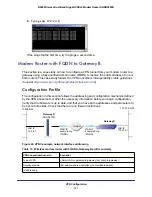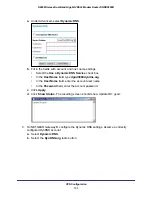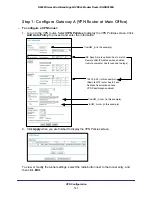
VPN Configuration
152
N600 Wireless Dual Band Gigabit VDSL2 Modem Router DGND3800B
Use a Fully Qualified Domain Name (FQDN)
Many ISPs provide connectivity to their customers using dynamic instead of static IP
addressing. This means that a user’s IP address does not remain constant over time, which
presents a challenge for gateways attempting to establish VPN connectivity.
A Dynamic DNS (DDNS) service allows a user whose public IP address is dynamically
assigned to be located by a host or domain name. It provides a central public database
where information (such as email addresses, host names, and IP addresses) can be stored
and retrieved. Now, a gateway can be configured to use a third-party service instead of a
permanent and unchanging IP address to establish bidirectional VPN connectivity.
To use DDNS, you have to register with a DDNS service provider. Some DDNS service
providers include:
•
DynDNS: www.dyndns.org
•
TZO.com: netgear.tzo.com
•
ngDDNS: ngddns.iego.net
In this example, Gateway A is configured using a sample FQDN provided by a DDNS service
provider. In this case the hostname dgnd3800.dyndns.org for Gateway A was provided using
the DynDNS service. Gateway B uses the DDNS service provider when establishing a VPN
tunnel.
To establish VPN connectivity, Gateway A has to be configured to use Dynamic DNS, and
Gateway B has to be configured to use a DNS host name provided by a DDNS service
provider to find Gateway A. Again, the following step-by-step procedures assume that you
have already registered with a DDNS service provider and have the configuration information
necessary to set up the gateways.
Step-by-Step Configuration
To configure a VPN tunnel:
1.
Log in to Gateway A (your modem router) as described in
Log In to the N600 Modem
Router
on page
18.
This example assumes that you have set the local LAN address as 10.5.6.1 for Gateway
A and have set your own password.
2.
On Gateway A, configure the Dynamic DNS settings.
Gateway A
Fully qualified domain name (FQDN)
Gateway B
FQDN
Table 13. Wireless modem router with FQDN to Gateway B profile summary (Continued)
VPN Consortium Scenario
Scenario 1
















































